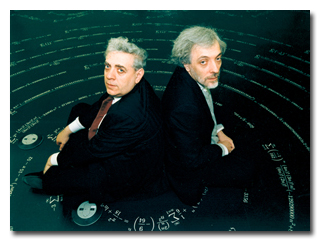-

After I posted that article about technical analysis a couple people commented that it reminded them of the film Pi, about a renegade mathematician somehow using Pi to search for patters in the stock market with a homemade supercomputer in his crummy Manhatten apartment.
Technical analysis was probably the inspiration for the stock market portion of the film, but did you know that the part about renegade mathematicians building supercomputers in their living rooms to calculate Pi is actually based on a true story? Aronofsky almost certainly took the inspiration from this 1992 New Yorker story:
Gregory Volfovich Chudnovsky recently built a supercomputer in his apartment from mail-order parts. Gregory Chudnovsky is a number theorist. His apartment is situated near the top floor of a run-down building on the West Side of Manhattan, in a neighborhood near Columbia University. Not long ago, a human corpse was found dumped at the end of the block. The world’s most powerful supercomputers include the Cray Y-MP C90, the Thinking Machines CM-5, the Hitachi S-820/80, the nCube, the Fujitsu parallel machine, the Kendall Square Research parallel machine, the NEC SX-3, the Touchstone Delta, and Gregory Chudnovsky’s apartment. The apartment seems to be a kind of container for the supercomputer at least as much as it is a container for people.
Gregory Chudnovsky’s partner in the design and construction of the supercomputer was his older brother, David Volfovich Chudnovsky, who is also a mathematician, and who lives five blocks away from Gregory. The Chudnovsky brothers call their machine m zero. It occupies the former living room of Gregory’s apartment, and its tentacles reach into other rooms. The brothers claim that m zero is a “true, general-purpose supercomputer,” and that it is as fast and powerful as a somewhat older Cray Y-MP, but it is not as fast as the latest of the Y-MP machines, the C90, an advanced supercomputer made by Cray Research. A Cray Y-MP C90 costs more than thirty million dollars. It is a black monolith, seven feet tall and eight feet across, in the shape of a squat cylinder, and is cooled by liquid freon. So far, the brothers have spent around seventy thousand dollars on parts for their supercomputer, and much of the money has come out of their wives’ pockets. […]
Pi is by no means the only unexplored number in the Chudnovskys’ inventory, but it is one that interests them very much. They wonder whether the digits contain a hidden rule, an as yet unseen architecture, close to the mind of God. A subtle and fantastic order may appear in the digits of pi way out there somewhere; no one knows. No one has ever proved, for example, that pi does not turn into nothing but nines and zeros, spattered to infinity in some peculiar arrangement. If we were to explore the digits of pi far enough, they might resolve into a breathtaking numerical pattern, as knotty as “The Book of Kells,” and it might mean something. It might be a small but interesting message from God, hidden in the crypt of the circle, awaiting notice by a mathematician. On the other hand, the digits of pi may ramble forever in a hideous cacophony, which is a kind of absolute perfection to a mathematician like Gregory Chudnovsky. Pi looks “monstrous” to him. “We know absolutely nothing about pi,” he declared from his bed. “What the hell does it mean? The definition of pi is really very simple—it’s just the ratio of the circumference to the diameter—but the complexity of the sequence it spits out in digits is really unbelievable. We have a sequence of digits that looks like gibberish.”
Since the publication of that story, the Brothers Chudnovsky have apparently turned their attentions to applying their expertise in supercomputing to other domains. Richard Preston, author of the original piece, wrote a follow-up for the New Yorker in 2005.
You can learn more about them on this NOVA page.
Reading all of this reminded me of a story I read earlier in the week about someone who claims to have “cracked the code” in Plato’s writings:
The hidden codes show that Plato anticipated the Scientific Revolution 2,000 years before Isaac Newton, discovering its most important idea – the book of nature is written in the language of mathematics. […]
However Plato did not design his secret patterns purely for pleasure – it was for his own safety. Plato’s ideas were a dangerous threat to Greek religion. He said that mathematical laws and not the gods controlled the universe. Plato’s own teacher had been executed for heresy. Secrecy was normal in ancient times, especially for esoteric and religious knowledge, but for Plato it was a matter of life and death. Encoding his ideas in secret patterns was the only way to be safe.
Manchester University: Science historian cracks “the Plato code”
(via Social Physicist)
technoccult posted this
Recent Post
Read more